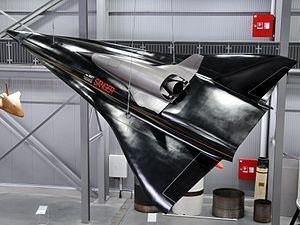 | ||
Saenger or Sänger was a concept design of a spaceplane. Its first design, Saenger I, was developed between 1961 and 1974 from plans originating from Eugen Sänger at the West German company Junkers.
Contents
Saenger I
The Saenger vehicle utilised a two-stage concept similar to that of the space shuttle. The first stage with the second stage attached on top would take off horizontally using a runway and climb to an altitude of 30 km using airbreathing ramjet engines. The second stage would then detach and accelerate to orbital speeds and altitudes using its LOX/LH2 rocket engine. The advantage of this approach is that the first stage utilises the advantages of air-breathing engines (such as higher specific impulse) until they are no longer viable due to low air pressure and high velocities. The second stage had dimensions of 31 m × 12 m and would have been capable of carrying two astronauts.
Saenger II
The saenger-II project grew out of Saenger I in the late 1980s and was planned to be a European launch vehicle emulating the successes of the space shuttle in the United States. The development was undertaken at Messerschmitt-Bölkow-Blohm. The vehicle would take off from a runway using ramjet engines and climb to 30 km altitude and reach Mach 7. The second stage would then detach, allowing the first stage to return to the original runway, and accelereate to orbital velocities and altitudes using its rocket engine. The spacecraft would have been able to deliver a payload of 10,000 kg or a crew module to low earth orbit.
The project was discontinued in 1995 primarily due to concerns of development costs and limited gains in price and performance compared to the existing expendable launcher programs such as Ariane V.
